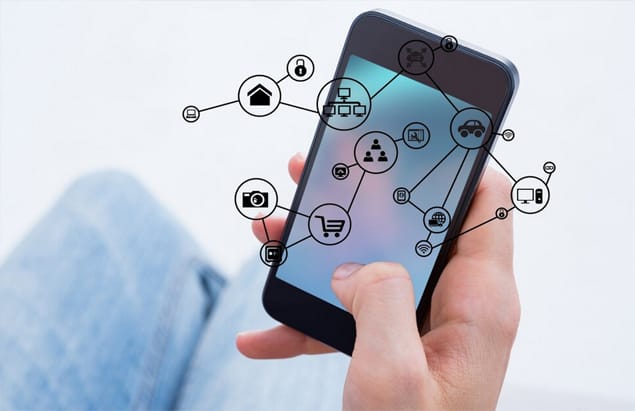
IoT App Development: The Internet of Things (IoT) has become integral to our daily lives, extending far beyond smart home systems and wearables. It is widely utilized in retail, large-scale manufacturing, and the financial sector. In addition, there is a growing demand for IoT mobile app development as various industries embrace modern technology. Statista predicts that the number of IoT devices worldwide will triple by 2030, going from 9.7 billion to 29 billion. However, what exactly is IoT, and why is it so important in today’s digital age?
The Internet of Things (IoT) is a network of interconnected objects with sensors. These objects transmit information across compatible communication networks, software applications, and multiple devices. With this technology, you can easily control all the machines and gadgets in the network. Staying connected and interacting with assets and resources is beneficial. Shortly, the Internet of Things will bring together different industries, creating a world that relies heavily on IoT applications.
Now is the perfect time for businesses to invest in IoT app development. Companies can seize the opportunities available today by staying up-to-date with the latest trends. This article provides a comprehensive guide to developing IoT applications. It covers the cost, recommended tools, and implementation process for integrating a new app into your business.
Most Significant Applications of IoT
Implementing IoT offers numerous opportunities for businesses. Additionally, it enhances the transparency and connectivity of processes. The technology utilizes artificial intelligence (AI) and machine learning (ML) to improve business data analysis. Now, let’s explore the various use cases of IoT apps across different industries and the additional benefits they offer enterprises.
Retail
Mobile apps for IoT have great potential in the retail industry. Thanks to their assistance, retailers can boost their business outcomes. For instance, integrating IoT technology allows for remote tracking and measurement of key supply chain operations, reducing operational costs. Mobile apps with AI and ML enhance the product lifecycle by efficiently tracking the entire process from production to logistics and distribution.
Manufacturing
Managers can easily access information about equipment conditions, fuel levels, and parts that need to be replaced with the help of the Internet of Things and augmented reality (AR). Our custom mobile apps for manufacturing help track the implementation of production tasks, preventing any potential issues. IoT solutions offer a range of features, including product equipment management systems, digital product quality control mechanisms, asset management systems, and more.
Healthcare
The healthcare industry extensively utilizes IoT technology. It has become a crucial aspect of app development in the industry. For instance, apps that monitor patients’ vitals through wireless scales and cuffs can easily send data directly to their medical records. Afterward, doctors or coaches assess the patient’s health and monitor any possible issues. Mobile apps powered by IoT technology can be utilized for various purposes, such as monitoring health, checking UV radiation and radiation levels in medical product storage, and analyzing environmental conditions.
Smart Home
Smart home automation is a major driver behind the growing demand for IoT development. Smartphones are now equipped with features that allow us to monitor and control electricity, gas, water, and even remote control systems and security easily. These capabilities have become a regular part of our daily lives. Smart homes enhance people’s comfort and convenience. Take Amazon Alexa, for instance. It’s a highly sought-after smart home device. With the Alexa mobile app, users can control appliances, switches, and thermostats simply by using voice commands.
Steps of IoT Mobile App Development
Efficient IoT development necessitates thoughtful preparation and execution. Here is a simple guide to help you better understand the process.
Step 1. Choose a platform
Once you’ve determined the main objectives for your app development, it’s time to consider whether you should start from scratch or utilize an existing off-the-shelf IoT platform. One benefit of the second option is its ability to rapidly create a complete cloud infrastructure for your IoT application.
However, not all businesses can benefit from ready-made platforms. So, it’s important to carefully check if your IoT app can work within the chosen technological limits. Selecting a pre-made platform can be challenging, as numerous factors must be carefully considered. Considering factors like network protocols, cloud architecture, hardware support, and scalability is essential.
Step 2. Take Care of the Security
Developing an IoT app involves creating a compact ecosystem with a web-based data processing application, an admin portal, a data visualization platform, and other modules. It highlights the importance of implementing a multi-layered security approach for IoT products. Consider it at the start of an app development process.
Look at essential factors for secure IoT apps, such as user authentication, data encryption, access rights management, etc. However, it is necessary to consider the trade-off between security requirements and user-friendliness.
Step 3. Development and Testing
During this stage, a mobile app development company collaborates closely with customers by going through the following steps: design, prototype, verification, coding, and testing. The main focus for IoT app developers is to carefully analyze the speed and performance of the software during the design process. A slight delay can have disastrous consequences since IoT applications rely on real-time data.
Developing mobile applications requires extensive testing. Furthermore, a comprehensive QA strategy involves incorporating automated tests into the code and evaluating app features from the customer’s point of view. Your app development team should conduct various types of testing to ensure the quality of your application. These include usability, security, scalability, compatibility, and performance testing.
Step 4. Deployment
Once the design has been developed and finalized, your IoT app is ready for deployment. Furthermore, it is essential for your mobile app developers to promptly address any issues that may arise even after this stage, short and simple to understand.
Step 5. Maintenance by Mobile app development company
After your product goes live, your development team will be focused on continuously enhancing the interface with new features and updates. Simply put, additional effort is required to improve your IoT application continuously.
Factors Affecting IoT App Development Cost
Various factors influence the pricing of IoT applications. There are three main aspects: hardware, infrastructure, and application. Now, we will provide a thorough description of each of them.
Hardware
Building a smart device makes up a significant portion, around 70-80%, of the total development cost. It also relies on the kind and intricacy of the IoT solution. Let’s explore the different stages of hardware design that impact the overall cost of developing an IoT application.
During this step, mobile app development companies go through an analysis process, plan budgets, develop concepts, and specify technical requirements.
Next comes the modeling stage. Engineers, in collaboration with industrial designers, focus on developing the device’s internal components.
Now, let’s move on to prototyping. The hardware device manufacturer debugs and modifies the developed PCBs.
Testing is the final stage. Prototypes that are successful progress to the pre-production stage. Next, tests are conducted, including electrical safety, climatic conditions, and user tests.
Infrastructure
Three components make up the infrastructure. Each element determines the overall cost of developing an IoT solution.
Network
For the IoT ecosystem to function effectively, it is essential to have a fast and reliable network infrastructure supporting high-speed connections, low latency, and scalability. LPWAN solutions and short-range wireless cellular technology provide seamless IoT connectivity. If you decide to create an IoT app using a network of connected devices, extra costs will be involved.
Middleware
When incorporating ready-made third-party gadgets into your IoT ecosystem, middleware is necessary. You will require software to connect multiple IoT components, as they will not function correctly without it.
Cloud-based infrastructure
Cloud computing solutions significantly impact the overall costs of app development. However, this plays a crucial role in the IoT ecosystem, as storage software processes and analyzes raw data.
Application
The complexity of the developed IoT application also plays a significant role in determining the total cost estimate. There are three levels of development difficulty: easy, moderate, and challenging. Now, let’s examine each of them.
This IoT app is called “simple” due to its development time of just 300 man-hours. However, mobile applications utilize intricate programming tools to display sensor data and generate real-time information. In addition, they seamlessly integrate with the custom tracker.
Applications developed using IoT technology that require around 1000 man-hours to create are considered average quality. These applications utilize Bluetooth low energy to make it easier to manage connected devices, view data, and share results on social media. The price for average IoT mobile app development falls within the moderate range.
iOS and Android mobile applications prioritizing security are often seen as more intricate. They can easily connect to monitoring devices via Bluetooth to generate reports and transmit data to the server. Developing an IoT mobile app, which includes authorization and a PIN code generator, requires approximately 2000 man-hours.
Nevertheless, there is more to it. Integrating AI or implementing IoT apps at the enterprise level can lead to additional hours and higher development costs. Furthermore, apart from the crucial factors mentioned earlier, the cost of developing an IoT app is influenced by the following aspects:
Considerations for mobile app development include the app’s functionality, loading features, project requirements, device connections, technology types, and location.
Now, let’s look at the overall price after considering all the important factors affecting IoT app development costs.
How Much Does It Cost To Make an IoT App?
The previous block shows that various factors influence the cost of IoT mobile app development. That’s why it’s essential to consider the complexity of the application when calculating the final price.
An IoT app typically has a price range of $30,000 to $40,000. However, it is essential to consider that we are discussing an IoT application with limited device connection options. This software offers minimal features, with simple connectivity and information display options.
If mobile apps have additional features, they will be considered more complex. For example, the cost of developing an IoT application that includes synchronization across devices, data encryption, geolocation, and payments will range from $50,000 to $80,000.
The average cost of developing an IoT app ranges from $20,000 to $60,000. It’s important to note that the development cost can vary depending on the company and location. As an illustration, a company specializing in IoT app development in Southeast Asia typically charges $20-40 per hour. In Eastern Europe, the average rate ranges from $30-50; in India, it falls between $25-50.
Final Words
There is a rising need for IoT technology in today’s world. Furthermore, its widespread use globally holds promising prospects. Various businesses from different industries have a keen interest in personalized IoT mobile applications, ranging from healthcare to automotive and security. Furthermore, multiple open-source platforms play a role in advancing IoT development. This trend and the rise of futuristic IoT applications will guide us towards a more interconnected society.




